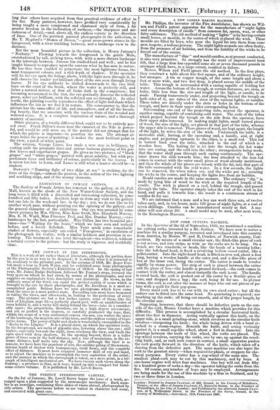THE CONWAY IN THE STEREOSCOPE.
This is a work of art rather than of literature, although the portion done by the pen is in no way to be despised; it is strictly what it is intended to be, auxiliary to the pictorial part. In the autumn of 1858, Mr. Roger Fen- ton made a tour in North Wales, and he exhibited some large photographs at the Photographic Society's Exhibition of 1858-9. In the spring of last year, Mr. James Budge Davidson followed Mr. Fenton's steps, retraced the very spots on which he had stood, by means of his photographs, and now supplies an explanatory text, descriptive and historical. No views, in the ordinary sense of the word, can equal the perfect reality of scene which is brought to the eye by these photographs, and Mr. Davidson is a most ac- complished guide. Seldom have we seen photograms which have come from the press in a more perfect state. Exceeding care must have been used in taking the views, and afterwards, in looking to the perfection of every copy. The pictures are but a few inches square, some of them, like the view of Llyglass, page 35—a perfectly placid pool, with an amphitheatre of trees behind it, and a rocky hill rising behind the trees—take in a consider- able space ; the proportions. therefore, are in a high degree microscopic, and yet so perfect is the impress, so carefully graduated the tone, that, within the scope of a very contracted camera obscura, you realize the space of the landscape, the majestic size of the trees, and the endless variety of vege- tative forms. The power of light and shade is wonderfully exemplified in the " Rocks in the Llugwy." It is a placid river, up which the spectator looks. In the foreground, are rocks of gigantic size, lowering above the eye ; still higher, especially towards the right, trees overhang the view, and vault the open space with deep shadows. In the opening beyond, there is a taller grove of trees seen in the half distance, and a line of mountains, in the ex- treme distance, half melts iuto the sky. Now, although the view is so minute, we have here the grandeur of size, the sublime piling of the scenery, intense depth of shadow with transparency, vivid forms, and the complete effect of distance. It must have required immense skill of eye and hand, so to adjust the machine as to accomplish the very aspiration of the artist; and the manner in which the stereograph is taken, as a mere print, is a tri- umph of intelligent mechanical art. We have twenty such views along the Conway ; a province is thus, as it were, bound up into a compact but hand- some octavo volume. It is published by Mr. Lovell Reeve.






























 Previous page
Previous page